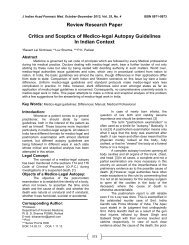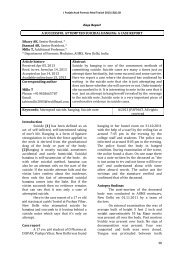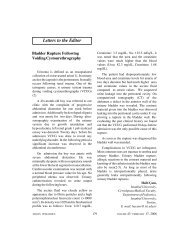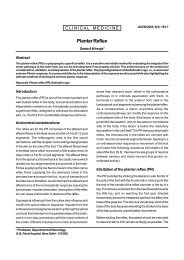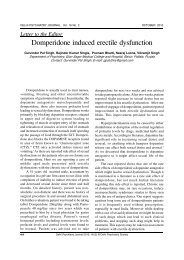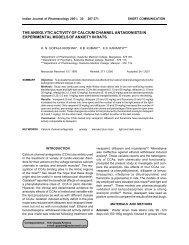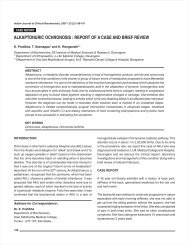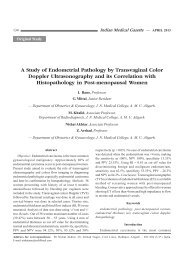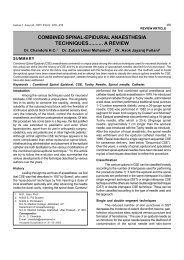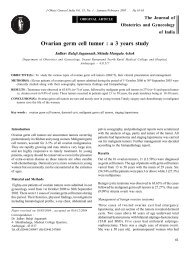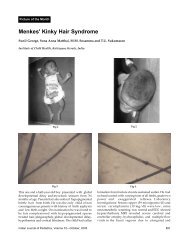Diabetic Neuropathy: Current Concepts - medIND
Diabetic Neuropathy: Current Concepts - medIND
Diabetic Neuropathy: Current Concepts - medIND
Create successful ePaper yourself
Turn your PDF publications into a flip-book with our unique Google optimized e-Paper software.
Management of diabetic gastroparesis consists of<br />
multiple small feedings, reduction in dietary fat,<br />
good glycaemic control, and prokinetic drugs. The<br />
prokinetic drugs used for the management of<br />
gastroparesis are metoclopramide (10-20 mg 6<br />
hourly), domperidone (10-20 mg 4-6 hourly),<br />
cisapride (10 mg 8 hourly), and erythromycin (250<br />
mg 8 hourly). All are given 1/2 hours before meal.<br />
In patients who are unable to tolerate oral<br />
medication, metoclopramide or erythromycin can<br />
be given intravenously. In case of severe<br />
gastroparesis, patients may require hospitalisation,<br />
intravenous fluids, parental drugs, and nasogastric<br />
drainage; sometime they may require intra-jejunal<br />
feeding.<br />
Enteropathy includes both diarrhoea and<br />
constipation. The pathogenesis of diabetic<br />
diarrhoea includes abnormalities in gastrointestinal<br />
motility, decreased gut transit time,<br />
reduced fluid absorption, bacterial overgrowth,<br />
pancreatic insufficiency, coexistent coeliac disease,<br />
and abnormalities in bile salt metabolism. The<br />
pathophysiology of diabetic constipation is poorly<br />
understood but may reflect loss of post-prandial<br />
gastrocolic reflex 49 .<br />
Loperamide, diphenoxylate, or codeine<br />
phosphate are used for symptomatic treatment<br />
of diabetic diarrhoea, while clonidine is used<br />
to reduce α2 adrenergic receptor mediated<br />
intestinal absorption. A short course of broad<br />
spectrum antibiotics (ampicillin, tetracycline) is<br />
helpful for diarrhoea due to bacterial overgrowth.<br />
Cystopathy<br />
Patients with neurogenic bladder may not be able<br />
to sense bladder fullness. The patients should be<br />
instructed to palpate their bladder. The bladder<br />
may be emptied by mechanical measures such as<br />
manual suprapubic pressure (Crede’s maneuver)<br />
or intermittent self catheterisation. Parasympathomimetic<br />
agents such as bethanechol are some<br />
times helpful but often do not help to fully empty<br />
the bladder. While extended sphincter relaxation<br />
can be achieved with an α1 blocker such as<br />
doxazosin. If pharmacological measures fail,<br />
bladder neck surgery (in males) may help to relieve<br />
spasm of the internal sphincter.<br />
Sexual dysfunction in males can be managed with<br />
intrapenile injection of papaverine and by vacuum<br />
devices. If these therapies do not help, rigid or<br />
semirigid prostheses are available. The drug<br />
sildenafil citrate is now being increasingly used to<br />
manage erectile dysfunction. Being a potent<br />
inhibitor of cyclic guanosine monophosphate<br />
hydrolysis in the corpus covernosum, it therefore<br />
increases the penile response to sexual stimulation.<br />
One randomised, double-blind, flexible-dose,<br />
placebo-controlled study included only patients<br />
with erectile dysfunction attributed to complications<br />
of diabetes mellitus (n = 268). Patients were<br />
started on 50 mg and allowed to adjust the dose<br />
upto 100 mg or down to 25 mg of sildenafil. There<br />
were highly statistically significant improvements<br />
(in frequency of successful penetration during<br />
sexual activity and maintenance of erections after<br />
penetration) on sildenafil compared to placebo.<br />
Table III : Tests of cardiac autonomic function.<br />
Test<br />
Parasympathetic (heart rate response)<br />
Normal Borderline Abnormal<br />
Valsalva (Valsalva ratio) ≥ 1.21 1.11-1.20 ≤ 1.10<br />
Deep breathing (max/min HR) ≥ 15 beat/min 11-14 beast/min ≤ 10 beats/min<br />
Standing (30:15 ratio R-R) ≥ 1.04 1.01-1.03 ≤ 1.00<br />
Sympathetic (blood pressure response)<br />
Standing (↓ systolic) ≤10 mm Hg 11-29 mm Hg ≥ 30 mm Hg<br />
Exercise (↑ diastolic) ≥16 mm Hg 11-15 mm Hg ≤ 10 mm Hg<br />
314 Journal, Indian Academy of Clinical Medicine Vol. 2, No. 4 October-December 2001





